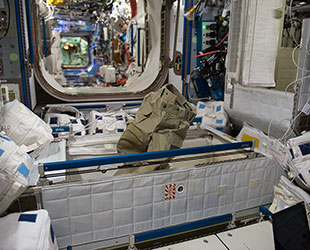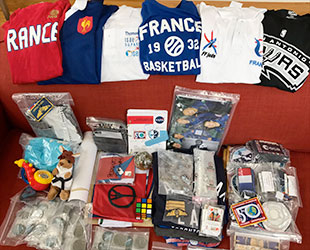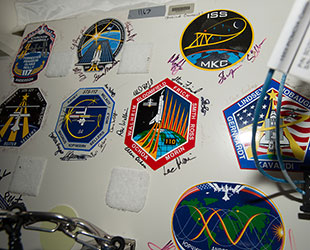August 1, 2017 — "Space archaeologist" would be a fine job description for a fictional character on an interplanetary mission to unearth the ruins of an alien civilization. But a handful of real-life archaeologists are already making a bid to study culture in space – of the human, not alien, variety.
A new effort, called ISS Archaeology, seeks to understand the "microsociety" aboard the International Space Station.
The plan is to treat the space lab like archaeologists would treat an ancient site. By looking at astronauts' artifacts — from their food utensils and sleeping bags to their religious icons and family photos — these researchers hope to gain new insights into how astronauts of different backgrounds interact with each other and adapt to life in microgravity.
Making space for archaeologists
The idea for the project was conceived in the fall of 2015, when NASA put out a call for applications for its astronaut program. The space agency no longer recruits only fighter pilots, but also doctors, electrical engineers, physicists and geologists. Archeologist Justin Walsh however noticed that social scientists were excluded from this mix, with degrees in anthropology, archaeology and geography, in particular, singled out as being disqualified.

A pair of pants floats above crew quarters aboard the International Space Station in December 2016. (NASA) |
"I thought that was too bad," Walsh, a Chapman University professor in California, told Space.com. "If they're thinking about sending people to Mars, sending people into deep space, or sending people to [the] moon for long periods of time, it would really behoove them to [better] understand how astronaut societies are maintained — how astronauts create a kind of culture."
In the most traditional sense, archaeologists' work might go like this: They'll go to an ancient site, dig a few trenches and systematically record all the artifacts and architectural features they found buried underground. They'll then use those subtle clues to understand how people lived in this particular place in the past. A piece of broken pottery, for instance, could reveal what the people were eating, or with whom they were trading hundreds of years ago.
Over the past several decades, archaeologists have been stretching the bounds of their field. Some don't ever pick up a trowel, but use satellite images to search for ancient sites (a different brand of "space archaeology" altogether). Others argue that archaeology doesn't need to be focused only on the past; archaeologists might be qualified to study how humans (even living humans) use their environment and material things, regardless of time.
At the same time, the Space Age is getting older. People interested in cultural heritage have started to wonder if the human footprint in space is worth carefully protecting. The broader archaeological community recently began to take this idea seriously, says space archaeologist Alice Gorman of Flinders University in Australia, who has researched the cultural significance of space junk, among other artifacts of spaceflight. The site where Apollo 11 landed on the moon has even been suggested to be a U.S. historic landmark.
A virtual space lab
Walsh and Gorman teamed up for a new project to study astronaut culture. The International Space Station was an obvious choice for a study site, they said, because it's the place where astronauts have spent the most time (crews have been continuously rotating through since 2000). The orbiting lab also contains a complexity of interactions and relationships — the crews are multigendered, multiethnic, multinational and multilingual.

One astronaut's space station mementos: ESA astronaut Thomas Pesquet shared this photo of his personal mission souvenirs after their return from the International Space Station. (ESA) |
The researchers plan to mine databases of all the objects that have ever been sent to the ISS, and they'll draw from the huge number of photos taken on board to create a 4D digital model of the space station. In this virtual space, the researchers hope to be able to track patterns of movement of the astronauts and objects over time, which might allow them to understand patterns of life on the space station in the same way they might when looking at a site on Earth. Walsh says they are faced with an overabundance of data, so one future aspect of the project could be crowdsourcing help from those who want to go virtual artifact hunting.
Psychologists and behavioral scientists already keep close tabs on astronauts' interactions. They run studies on the ISS and in analog environments like the HI-SEAS habitat in Hawaii to understand the effects of long-term isolation. The astronauts themselves have also spoken extensively about their experiences, and social media has allowed for an even closer look at the minutiae of life on the ISS, from how astronauts make sandwiches to how they play pranks on each other.
Still, Walsh and Gorman think an archaeological approach might uncover some overlooked details, such as design insights that could be useful to space agency managers. (Perhaps they'll notice improvisations the astronauts make with their supplies.) The researchers also expect that they might find clues about how Russian, European, Japanese and U.S. astronauts distinguish or integrate themselves or integrate themselves aboard the ISS, and how tension can arise over material things.

Stickers representing insignia of past space shuttle missions and past expeditions are encircled by signatures of the crew members who visited and lived at the International Space Station. (NASA) |
In 2009, a Russian commander on the station complained that cosmonauts had been barred from using American exercise equipment and other facilities, which he said was having an adverse effect on the crew's morale and work. Walsh said that the project will test whether traces of such conflicts can be found in the "archaeological record" of the space station.
The project team members also anticipate a future when the station is gone. For now, the orbiting laboratory is set to be decommissioned in 2024. Eventually, it will fall out of the sky into an undersea spacecraft cemetery in a remote part of the Pacific Ocean. "This is a site that will no longer exist," Walsh said. So, perhaps at the least, the records of ISS Archaeology might be of value to archaeologists of the future.
A version of this article originally ran on Space.com on July 17, 2017. It is reprinted with permission.
